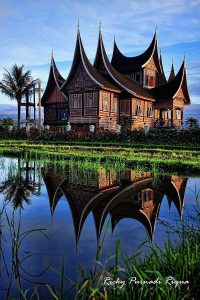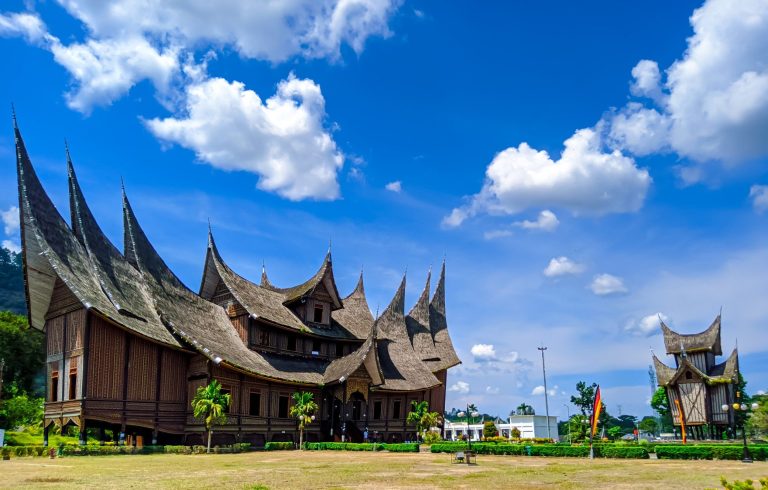The Minangkabau people, indigenous to the enchanting highlands of West Sumatra, Indonesia, boast a unique cultural identity that is intricately woven into the fabric of their traditional architecture.
At the heart of their cultural expression stands the iconic Rumah Gadang, a symbol of heritage and community deeply rooted in the rich history of the Minangkabau.
Historical Significance: Rumah Gadang Unveiled
Translated as “big house,” Rumah Gadang is the traditional abode of the Minangkabau, with its smaller counterparts sharing the same architectural essence.
The houses are not merely structures; they are living repositories of history, reflecting the culture and values of the matrilineal Minangkabau society.
Matrilineal in nature, the ownership of Rumah Gadang is passed from mother to daughter, symbolizing a lineage of strength and continuity.
A visual masterpiece, Rumah Gadang’s distinctive features include a horn-shaped roof crafted from thatch and wood.
The houses are elevated on pillars, creating a sense of grandeur and offering a spacious interior that accommodates multiple families.
Intricate details in both internal and external decorations tell stories of tradition, mythology, and communal identity.
What Ceremony Held at Rumah Gadang?
- The Rumah Gadang is not just a physical space; it is a sacred arena for various Minangkabau ceremonies. These ceremonies are deeply embedded in the cultural tapestry of the community, breathing life into the majestic abode. Here are some of the traditional ceremonies held within the Rumah Gadang:
- Turun Mandi: A celebration of new life, this ceremony involves the bathing of a newborn seven days after their birth. It symbolizes purification, health, and the welcoming of the newest member into the Minangkabau community.
- Weddings: The Rumah Gadang serves as the enchanting backdrop for weddings, a pivotal event in Minangkabau culture. These ceremonies celebrate love, unity, and the forging of new family bonds, echoing through the generations.
- Batagak Pangulu: A ceremony that elevates a clan leader, Batagak Pangulu is a testament to the Minangkabau’s commitment to preserving their hierarchical structures and honoring leadership within the community.
- Care for the Ailing: Beyond celebrations, the Rumah Gadang transforms into a sanctuary for family members facing illnesses. The communal nature of the house fosters a spirit of care and support during challenging times.
These ceremonies, among many others, illustrate the dynamic role the Rumah Gadang plays in Minangkabau life.
The architecture, construction, and the symbology behind the house resonate with the values of community, continuity, and cultural pride.

Various Styles of Minangkabau Traditional Houses
In the captivating landscape of Luhak Nan Tigo, traditional Minangkabau homes unfold in an array of styles.
Each telling a unique tale of cultural significance. Let’s explore these architectural wonders:
1. Gajah Maharam
Embarking on a luxurious journey, this type of Rumah Gadang in West Sumatra demands attention.
Positioned facing north, its walls adorned with sasak, this earthquake-resistant beauty stands proud with a roof of zinc.
Crafted from premium woods like juar, surian, and ruyung, it boasts four rooms, each door adorned with distinct Minangkabau carvings, upheld by 30 sturdy pillars.
2. Rumah Gadang Gonjong Limo
Dancing between tradition and modernity, this enchanting dwelling graces the streets of Kota Payakumbuh, Padang.
With ‘gonjong’ on both sides, it echoes the structure of Gajah Maharam but skips the additional platforms, adding its unique rhythm to the architectural symphony.
3. Gonjong Ampek Baanjuang
A symbol of local customs, this Rumah Gadang is a must in the tapestry of Luhak Nan Tigo.
True to its name, ‘Ampek’ meaning four, it proudly wears four ‘gojong’ on its roof, boasting more than seven rooms.
A touch of uniqueness comes with additional platforms on both flanks.
4. Rumah Gadang Batingkek
Harkening back to a bygone era, the Rumah Gadang Batingkek stands as a multi-tiered relic.
Once a common sight in Padang, its tiered ‘gonjong’ structure now graces the city’s landscapes as a rare gem, a testament to the evolution of architectural preferences.
5. Gonjong Anam
In the realm of Padang-style traditional homes, Gonjong Anam stands out.
Resembling the iconic Gajah Maharam Rumah Gadang but etched with unique Minangkabau carvings, it takes a modern twist.
Wooden planks replace bamboo weaving, and ample windows welcome streams of natural light into its contemporary interior.
6. Rumah Gadang Surambi Papek
Breaking the mold, the Rumah Gadang Surambi Papek offers a distinctive experience.
Traditionally entered through the back, reflecting the Minang language’s ‘papek,’ some have embraced modernity, featuring front doors.
A testament to adaptation and time’s influence on architectural narratives.
7. Gonjong Sibak Baju
Art imitating life, the Gonjong Sibak Baju mirrors the graceful split of a garment.
Borrowing from the iconic Rumah Gadang Gajah Maharam, this Padang traditional house, crafted from wood and sasak, adds its unique flair to the rich cultural panorama.
Also Read Apa Itu Sistem Kekerabatan Matrilineal di Minangkabau?
Conclusion
The Minangkabau traditional house, Rumah Gadang, stands not only as a physical structure but as a living testament to the cultural richness and historical depth of the Minangkabau people.
Its unique architecture and role in hosting traditional ceremonies showcase the enduring spirit of a community that cherishes its roots while embracing the evolving dynamics of the present.
The Rumah Gadang is more than a house; it is a sacred space where the past, present, and future of the Minangkabau come together in a harmonious dance of tradition and modernity.

